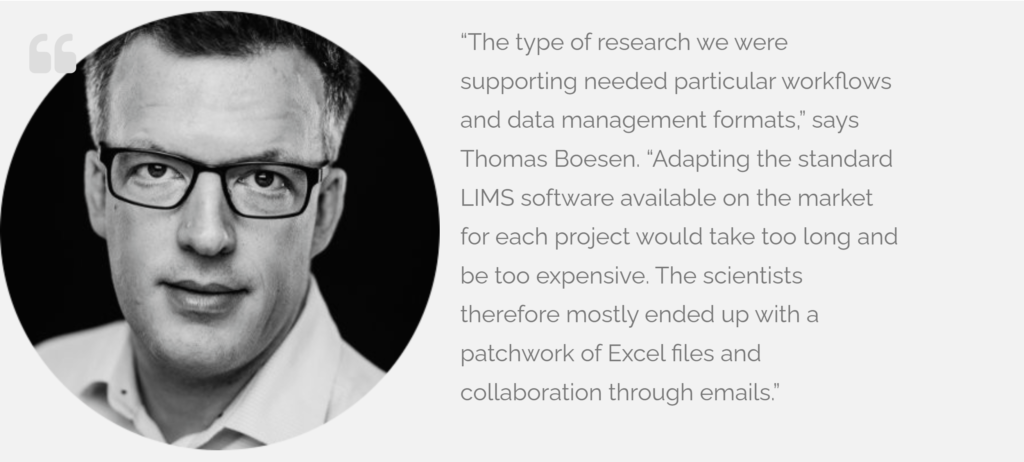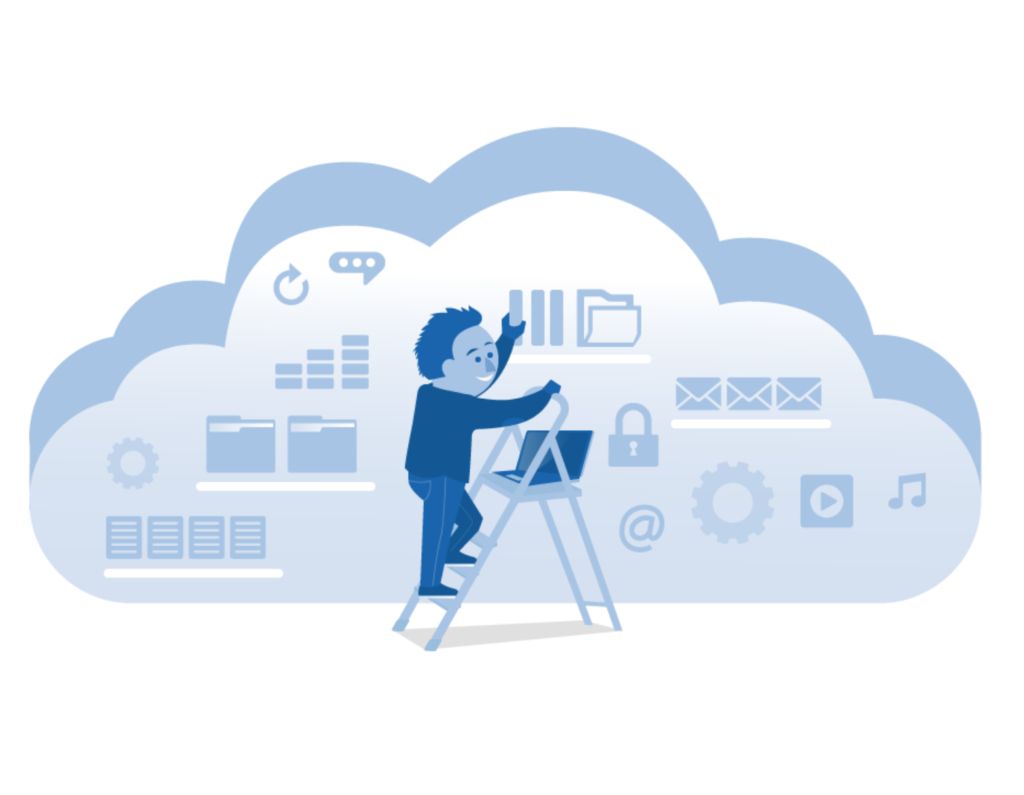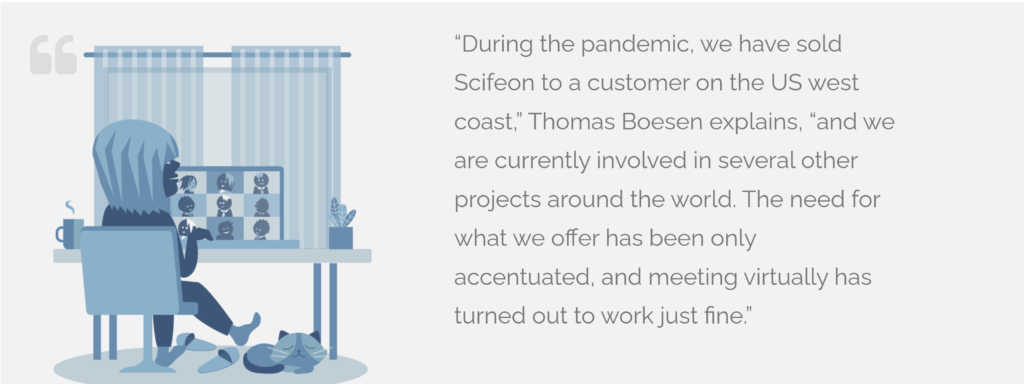SCIFEON – CUSTOMISABLE WORKFLOW & COLLABORATION SOFTWARE FOR THE LIFE SCIENCE RESEARCH LABORATORY
By Hans Peter Bech
Life science research laboratories need workflow & collaboration software they can easily customise to support their project-specific requirements. Such software is usually labelled LIMS (Laboratory Information Management Systems) and ELN (Electronic Laboratory Notebook). Still, the life science research laboratory’s software needs are very different from the needs of laboratories in other industries.
The work performed in the research laboratories in the life science industry plays a crucial role in how fast investments in new drugs and treatments will pay back. The speedier the turnaround you can achieve in the labs, the faster the product can be in the market before the exclusivity from the patents expires. In this context, each day can be worth millions of dollars.
Providing scientists with tools to support their collaboration and workflows and giving them instant access to data across projects will improve the throughput and quality of their work. Scientists and labs are scarce resources and eliminating manual and error-prone routines are in everyone’s interest. A scientist wants to spend her time conducting research and not moving paper around, digging through emails and chasing Excel files in hidden folders.
However, the requirements are not identical across research programs. To achieve smooth operations and high-quality results, the workflow and collaboration software must, therefore, be customised to each project.
The challenges and needs described above are the foundation of Scifeon, a Copenhagen based software startup.
A FOUNDER WITH A DUAL SKILLSET
Thomas Boesen, the CEO and founder of Scifeon, has developed software for more than twenty years. After completing his PhD in protein chemistry in 2002, he worked as an IT consultant helping fellow scientists develop databases and other software tools for life science and biotech research laboratories. The gigs included workflow, business intelligence and data warehouse projects based on LIMS and ELN systems, laboratory logistics simulators and laboratory scheduling software.
During his time with Novo Nordisk, where he led a research informatics innovation group, he saw an opportunity in the market. One of the projects he led was developing an execution support and workflow system to facilitate high-throughput molecular biology research.

Excel is by far the most frequently used software for managing scientific laboratory projects. It may do the job for the individual scientist, but it doesn’t deliver for planning, coordination, management, and collaboration purposes within and across projects.
“Excel is a great tool with which all scientists are familiar. There is no need to ditch it,” emphasises Thomas Boesen. “What is needed is a suite of applications that embrace it and takes care of all the other science-related tasks in the laboratory.”
With this use case in mind, Thomas Boesen left Novo Nordisk in 2016 and started Scifeon.
THE CUSTOMISABLE SCIENTIFIC WORKFLOW AND COLLABORATION SOLUTION

As I try to fit Scifeon into one of the industry categories defined by the market intelligence analysts, Thomas Boesen keeps stressing that Scifeon is not a classic LIMS product. He will accept that it is an ELN product and that maybe it could be called Research LIMS, but that is as far as I can push him.
It turns out that the availability of LIMS as a standard software product coincided with the proliferation of the minicomputer in the early 1980s.
Back then, the software predominantly targeted environmental, research, or commercial analysis such as pharmaceutical or petrochemical work.
“There is a huge difference between the work in a laboratory performing standardised routine analysis and what’s going on in a life science research lab,” Thomas Boesen tells me. “I, therefore, avoid the term LIMS since it refers primarily to the first category, which is not the market we address.”
Scifeon is specifically developed for the work undertaken in the research laboratories of the life science industries. It is delivered from the cloud as a service and is charged for on a subscription basis.
“Delivering SaaS from the cloud is almost the standard these days,” says Thomas Boesen. “What makes us different is that we also deliver an SDK (software development kit) allowing our customers to adapt the software to match the requirements of each research project.”
When setting up Scifeon, the customer gets a development instance and a production instance. It allows them to set up and test new workflows and database configurations before implementing them in the production environment.

Customisation can be done at many levels, from web-based system configuration to complex components. You can add your own tables, columns, and views. The features are also integrated with a DevOps setup, enabling you to automatically test and deploy updates so that new functionality can be deployed quickly and safely.
When a new version of the software gets released, it is tested on the development system first. If any issues are identified, they get fixed before implemented on the production system. This architecture enables the customers to verify their customisations before taking them live.
“Fast customisation is key,” Thomas Boesen stresses. “However, workflow, collaboration and database management support for scientific labs must be adapted to the individual project to be effective. While we are prepared to help our customers do this, our ultimate objective is to enable them to perform these customisations themselves.”
VERIFIED BY MARKET ACCEPTANCE
The Scifeon approach is innovative and different from the mainstream LIMS and ELN offerings. Embracing the need for user-performed project-level customisations is the north star for the company’s development efforts.
While differentiation is excellent for market communication purposes, it may push you into the challenges of the law of diffusion of innovation. According to this law, only around 20 per cent of potential customers will embrace innovative technology. The remaining 80 per cent will wait until the technology matures and becomes available from the established market leaders.
“We were well aware of the risk associated with pushing an innovative approach,” Thomas Boesen admits, “and I am not claiming that the law of diffusion of innovation doesn’t apply to us. We have nevertheless been able to win some very prestigious customers. Maybe there is a higher portion of technology enthusiasts and visionaries among life scientists?”
That may be the explanation for the impressive reference list Scifeon can show off.
On top of regular customer implementations, Scifeon has also been invited to provide the platform for the ambitious EU-sponsored CARE program, where the life science industry and universities have joined forces to find treatments for current and future variants of the covid virus. Scifeon’s software will collect, process, and share research data and act as a collaboration hub for the 37 partners in the five years the CARE program runs.
A COVID-RESISTANT BUSINESS MODEL?
When the Covid-19 pandemic struck, Scifeon was just about to scale its marketing efforts.
Winning customers for a Scifeon solution, which falls into the enterprise software category, typically requires several meetings before a pilot project is initiated and the final rollout gets approved.
Thomas Boesen was not worried about the pandemic’s impact on the life sciences’ need for workflow, collaboration and data management systems in their labs. Still, he was concerned about not being able to meet face-to-face with the customers.
His concerns turned out to be unfounded.

Being a small startup with limited resources and no international representation, the virtual operational format will significantly impact how Scifeon can scale its business model. If customers are prepared to accept virtual meetings during their buying, validation and implementation process, then Scifeon can scale much faster and with much less customer acquisition cost.
“The virtual format is to the customers’ benefit also,” Thomas Boesen points out. “Only a few companies have their key team members in the same location. Having to travel to a physical meeting not only adds cost. It is always a logistical nightmare finding physical meeting options in the calendars of busy people.”
The pandemic has pushed companies to make the virtual working and meeting format function. When you cannot meet and work around the same whiteboard, you will have to find ways to do the same with digital tools.
“We have developed a format that seems to work for the customers as well as for us,” Thomas Boesen concludes. “We will continue to push and refine the virtual format since it makes it so much easier for all of us. When customers realise that they need a new and better solution for their labs, they want to harvest the benefits as fast as possible. Delaying a project is not to anyone’s advantage.”
5,760 MILES FROM SILICON VALLEY
Wrapping up the interview with Thomas Boesen, I am once again amazed by what’s going on in the software industry outside the Silicon Valley.
Scifeon is located in an office hotel on Copenhagen’s outskirts. Checking the company page on LinkedIn, 18 people work here.
The interview has reconfirmed that innovation and disruptive business models in the software industry are not exclusively a Silicon Valley phenomenon. They may have most of the money, but they don’t have most of the brains.
For more information, please visit www.scifeon.com or contact Thomas Boesen at +45 5124 9454 or boesen@scifeon.com
